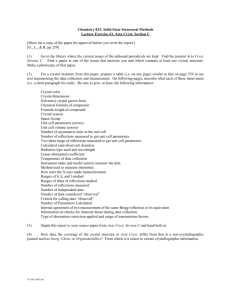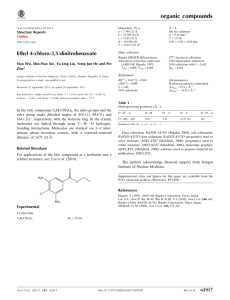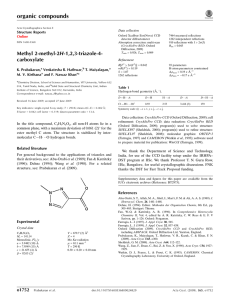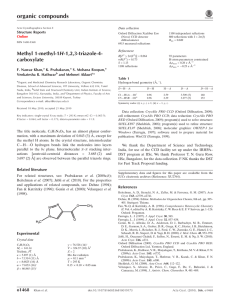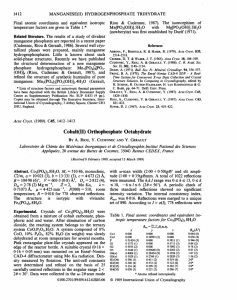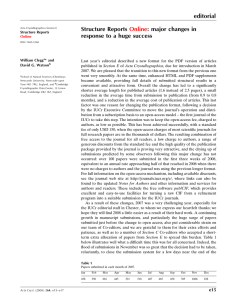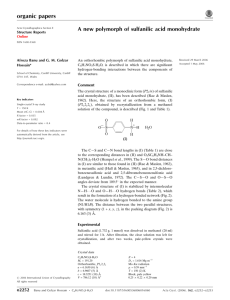Choline dihydrogen phosphate
advertisement
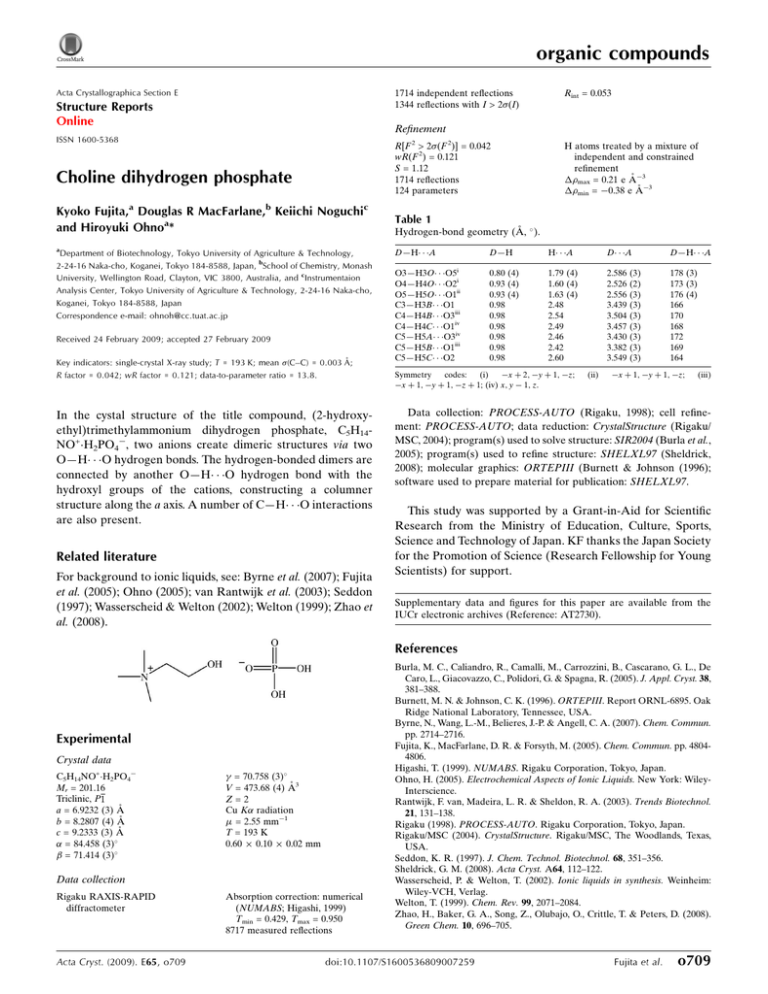
organic compounds Acta Crystallographica Section E 1714 independent reflections 1344 reflections with I > 2(I) Structure Reports Online Rint = 0.053 Refinement ISSN 1600-5368 R[F 2 > 2(F 2)] = 0.042 wR(F 2) = 0.121 S = 1.12 1714 reflections 124 parameters Choline dihydrogen phosphate Kyoko Fujita,a Douglas R MacFarlane,b Keiichi Noguchic and Hiroyuki Ohnoa* Table 1 a D—H A Department of Biotechnology, Tokyo University of Agriculture & Technology, 2-24-16 Naka-cho, Koganei, Tokyo 184-8588, Japan, bSchool of Chemistry, Monash University, Wellington Road, Clayton, VIC 3800, Australia, and cInstrumentaion Analysis Center, Tokyo University of Agriculture & Technology, 2-24-16 Naka-cho, Koganei, Tokyo 184-8588, Japan Correspondence e-mail: ohnoh@cc.tuat.ac.jp Received 24 February 2009; accepted 27 February 2009 Key indicators: single-crystal X-ray study; T = 193 K; mean (C–C) = 0.003 Å; R factor = 0.042; wR factor = 0.121; data-to-parameter ratio = 13.8. In the cystal structure of the title compound, (2-hydroxyethyl)trimethylammonium dihydrogen phosphate, C5H14NO+H2PO4, two anions create dimeric structures via two O—H O hydrogen bonds. The hydrogen-bonded dimers are connected by another O—H O hydrogen bond with the hydroxyl groups of the cations, constructing a columner structure along the a axis. A number of C—H O interactions are also present. Related literature For background to ionic liquids, see: Byrne et al. (2007); Fujita et al. (2005); Ohno (2005); van Rantwijk et al. (2003); Seddon (1997); Wasserscheid & Welton (2002); Welton (1999); Zhao et al. (2008). H atoms treated by a mixture of independent and constrained refinement max = 0.21 e Å3 min = 0.38 e Å3 Hydrogen-bond geometry (Å, ). i O3—H3O O5 O4—H4O O2i O5—H5O O1ii C3—H3B O1 C4—H4B O3iii C4—H4C O1iv C5—H5A O3iv C5—H5B O1iii C5—H5C O2 D—H H A D A D—H A 0.80 (4) 0.93 (4) 0.93 (4) 0.98 0.98 0.98 0.98 0.98 0.98 1.79 (4) 1.60 (4) 1.63 (4) 2.48 2.54 2.49 2.46 2.42 2.60 2.586 2.526 2.556 3.439 3.504 3.457 3.430 3.382 3.549 178 (3) 173 (3) 176 (4) 166 170 168 172 169 164 Symmetry codes: (i) x þ 2; y þ 1; z; x þ 1; y þ 1; z þ 1; (iv) x; y 1; z. (ii) (3) (2) (3) (3) (3) (3) (3) (3) (3) x þ 1; y þ 1; z; (iii) Data collection: PROCESS-AUTO (Rigaku, 1998); cell refinement: PROCESS-AUTO; data reduction: CrystalStructure (Rigaku/ MSC, 2004); program(s) used to solve structure: SIR2004 (Burla et al., 2005); program(s) used to refine structure: SHELXL97 (Sheldrick, 2008); molecular graphics: ORTEPIII (Burnett & Johnson (1996); software used to prepare material for publication: SHELXL97. This study was supported by a Grant-in-Aid for Scientific Research from the Ministry of Education, Culture, Sports, Science and Technology of Japan. KF thanks the Japan Society for the Promotion of Science (Research Fellowship for Young Scientists) for support. Supplementary data and figures for this paper are available from the IUCr electronic archives (Reference: AT2730). References Experimental Crystal data C5H14NO+H2PO4 Mr = 201.16 Triclinic, P1 a = 6.9232 (3) Å b = 8.2807 (4) Å c = 9.2333 (3) Å = 84.458 (3) = 71.414 (3) = 70.758 (3) V = 473.68 (4) Å3 Z=2 Cu K radiation = 2.55 mm1 T = 193 K 0.60 0.10 0.02 mm Data collection Rigaku RAXIS-RAPID diffractometer Acta Cryst. (2009). E65, o709 Absorption correction: numerical (NUMABS; Higashi, 1999) Tmin = 0.429, Tmax = 0.950 8717 measured reflections Burla, M. C., Caliandro, R., Camalli, M., Carrozzini, B., Cascarano, G. L., De Caro, L., Giacovazzo, C., Polidori, G. & Spagna, R. (2005). J. Appl. Cryst. 38, 381–388. Burnett, M. N. & Johnson, C. K. (1996). ORTEPIII. Report ORNL-6895. Oak Ridge National Laboratory, Tennessee, USA. Byrne, N., Wang, L.-M., Belieres, J.-P. & Angell, C. A. (2007). Chem. Commun. pp. 2714–2716. Fujita, K., MacFarlane, D. R. & Forsyth, M. (2005). Chem. Commun. pp. 48044806. Higashi, T. (1999). NUMABS. Rigaku Corporation, Tokyo, Japan. Ohno, H. (2005). Electrochemical Aspects of Ionic Liquids. New York: WileyInterscience. Rantwijk, F. van, Madeira, L. R. & Sheldon, R. A. (2003). Trends Biotechnol. 21, 131–138. Rigaku (1998). PROCESS-AUTO. Rigaku Corporation, Tokyo, Japan. Rigaku/MSC (2004). CrystalStructure. Rigaku/MSC, The Woodlands, Texas, USA. Seddon, K. R. (1997). J. Chem. Technol. Biotechnol. 68, 351–356. Sheldrick, G. M. (2008). Acta Cryst. A64, 112–122. Wasserscheid, P. & Welton, T. (2002). Ionic liquids in synthesis. Weinheim: Wiley-VCH, Verlag. Welton, T. (1999). Chem. Rev. 99, 2071–2084. Zhao, H., Baker, G. A., Song, Z., Olubajo, O., Crittle, T. & Peters, D. (2008). Green Chem. 10, 696–705. doi:10.1107/S1600536809007259 Fujita et al. o709 supporting information supporting information Acta Cryst. (2009). E65, o709 [doi:10.1107/S1600536809007259] Choline dihydrogen phosphate Kyoko Fujita, Douglas R MacFarlane, Keiichi Noguchi and Hiroyuki Ohno S1. Comment Some ionic liquids (ILs) possess negligible vapor pressure as well as fascinating features such as high thermal, chemical and electrochemical stability. ILs have gained increasing attention as green, multi-use reaction media as well as solvents for a electrochemistry and chemistry (Welton, 1999; Seddon, 1997; Wasserscheid & Welton, 2002). ILs are also currently being investigated for a variety of bio-applications including media for biocatalytic reactions (van Rantwijk et al., 2003; Zhao et al., 2008), biosensors (Ohno, 2005) and protein stabilization (Fujita et al., 2005; Byrne et al., 2007). We have been studying hydrated IL as solvents for proteins. We have already reported that some proteins are soluble, stable, and remain active in some hydrated ILs. For example, the title compounds, acts as an excellent preserver of proteins such as cytochrome c. The title compound (I) consists of cations and anions. The molecular structures of (I) are shown in Fig. 1. Two hydrogen bonds of O4—H···O2 connect anions and construct dimer along the b axis (Fig. 2). The dimers are connected with each other by the two hydrogen bonds of O5—H···O1 and O3—H···O5, through the hydroxyl group (Table 1). These hydrogen bonds create a columnar structure of anions and cations along the a axis. The columnar structures interact with each other by C—H···O hydrogen bond and van der Waals forces (Table 1). S2. Experimental Choline bromide solution was treated on an ion exchange resin (Amberlite IRN77), then mixed with phosphoric acid solution. The solvent evaporated and the product was dried in vacuo. White powder was dissolved in methanol, then reprecipited by dropping in acetone. This reprecipitation was repeated four times. Final purification was achieved by drowning-out crystallization from methanol solution. Aceton was used as antisolvent. This drowning-out crystallization was repeated twice at room temperature for X-ray measurements. The compound was identified using 1H NMR, DSC and Electrospray mass spectrometry. S3. Refinement The H atoms of the OH groups were found in difference maps and refined freely. The other C-bound H atoms were subsequently refined as riding atoms, with C—H = 0.98 and 0.99Å and Uiso(H) = 1.2 or 1.5Ueq(C). Acta Cryst. (2009). E65, o709 sup-1 supporting information Figure 1 Displacement ellipsoid plot and atomic numbering scheme of (I). Ellipsoids are drawn at the 50% probability level and H atoms are shown as small spheres of arbitary radii. Acta Cryst. (2009). E65, o709 sup-2 supporting information Figure 2 The molecular packing of (I) viewed along b axis. Dashed lines indicate intermolecular O—H···O hydrogen bonds. For clarity, only H atoms involved in O—H···O hydrogen bonding have been included. [Symmetry codes: (i) -x + 2, -y + 1, -z; (ii) -x + 1, -y + 1, -z.] (2-hydroxyethyl)trimethylammonium dihydrogen phosphate Crystal data C5H14NO+·H2PO4− Mr = 201.16 Triclinic, P1 Hall symbol: -P 1 a = 6.9232 (3) Å b = 8.2807 (4) Å c = 9.2333 (3) Å Acta Cryst. (2009). E65, o709 α = 84.458 (3)° β = 71.414 (3)° γ = 70.758 (3)° V = 473.68 (4) Å3 Z=2 F(000) = 216 Dx = 1.410 Mg m−3 sup-3 supporting information µ = 2.55 mm−1 T = 193 K Platelet, colourless 0.60 × 0.10 × 0.02 mm Melting point: 392 K Cu Kα radiation, λ = 1.54187 Å Cell parameters from 6930 reflections θ = 5.1–68.3° Data collection 8717 measured reflections 1714 independent reflections 1344 reflections with I > 2σ(I) Rint = 0.053 θmax = 68.3°, θmin = 5.1° h = −8→8 k = −9→9 l = −11→11 Rigaku RAXIS-RAPID diffractometer Radiation source: rotating anode Graphite monochromator Detector resolution: 10.00 pixels mm-1 ω scans Absorption correction: numerical (NUMABS; Higashi, 1999) Tmin = 0.429, Tmax = 0.950 Refinement Refinement on F2 Least-squares matrix: full R[F2 > 2σ(F2)] = 0.042 wR(F2) = 0.121 S = 1.12 1714 reflections 124 parameters 0 restraints Primary atom site location: structure-invariant direct methods Secondary atom site location: difference Fourier map Hydrogen site location: difference Fourier map H atoms treated by a mixture of independent and constrained refinement w = 1/[σ2(Fo2) + (0.0626P)2 + 0.050P] where P = (Fo2 + 2Fc2)/3 (Δ/σ)max < 0.001 Δρmax = 0.21 e Å−3 Δρmin = −0.38 e Å−3 Special details Geometry. All e.s.d.'s (except the e.s.d. in the dihedral angle between two l.s. planes) are estimated using the full covariance matrix. The cell e.s.d.'s are taken into account individually in the estimation of e.s.d.'s in distances, angles and torsion angles; correlations between e.s.d.'s in cell parameters are only used when they are defined by crystal symmetry. An approximate (isotropic) treatment of cell e.s.d.'s is used for estimating e.s.d.'s involving l.s. planes. Refinement. Refinement of F2 against ALL reflections. The weighted R-factor wR and goodness of fit S are based on F2, conventional R-factors R are based on F, with F set to zero for negative F2. The threshold expression of F2 > σ(F2) is used only for calculating R-factors(gt) etc. and is not relevant to the choice of reflections for refinement. R-factors based on F2 are statistically about twice as large as those based on F, and R- factors based on ALL data will be even larger. Fractional atomic coordinates and isotropic or equivalent isotropic displacement parameters (Å2) P1 O1 O2 O3 O4 O5 N1 C1 H1A H1B C2 H2A x y z Uiso*/Ueq 0.81645 (9) 0.5777 (2) 0.9220 (3) 0.9039 (3) 0.8798 (3) 0.7017 (3) 0.4405 (3) 0.5122 (4) 0.5978 0.3832 0.6444 (4) 0.7750 0.68990 (7) 0.7534 (2) 0.50241 (19) 0.8007 (2) 0.7343 (2) 0.2172 (2) 0.2917 (2) 0.3227 (3) 0.4020 0.3801 0.1635 (3) 0.1035 0.17447 (6) 0.24514 (18) 0.19693 (17) 0.25187 (19) 0.00080 (18) −0.10979 (19) 0.3125 (2) 0.1424 (2) 0.1227 0.1096 0.0453 (2) 0.0755 0.0335 (2) 0.0430 (5) 0.0439 (5) 0.0390 (4) 0.0406 (4) 0.0452 (5) 0.0340 (5) 0.0342 (5) 0.041* 0.041* 0.0391 (6) 0.047* Acta Cryst. (2009). E65, o709 sup-4 supporting information H2B C3 H3A H3B H3C C4 H4A H4B H4C C5 H5A H5B H5C H3O H4O H5O 0.5596 0.3093 (4) 0.1821 0.3958 0.2640 0.3029 (4) 0.1836 0.2458 0.3893 0.6299 (4) 0.7117 0.5805 0.7219 1.025 (5) 0.959 (6) 0.597 (5) 0.0844 0.4616 (3) 0.5104 0.5391 0.4464 0.1774 (3) 0.2257 0.1681 0.0636 0.2169 (3) 0.1024 0.2089 0.2902 0.793 (4) 0.643 (5) 0.232 (4) 0.0584 0.3894 (3) 0.3547 0.3633 0.5003 0.3487 (3) 0.3057 0.4597 0.3042 0.3699 (3) 0.3255 0.4815 0.3403 0.209 (3) −0.067 (4) −0.158 (4) 0.047* 0.0417 (6) 0.050* 0.050* 0.050* 0.0458 (7) 0.055* 0.055* 0.055* 0.0435 (6) 0.052* 0.052* 0.052* 0.058 (9)* 0.096 (12)* 0.090 (12)* Atomic displacement parameters (Å2) P1 O1 O2 O3 O4 O5 N1 C1 C2 C3 C4 C5 U11 U22 U33 U12 U13 U23 0.0331 (4) 0.0311 (9) 0.0622 (11) 0.0323 (9) 0.0474 (10) 0.0372 (9) 0.0408 (11) 0.0372 (12) 0.0421 (13) 0.0476 (14) 0.0574 (16) 0.0506 (15) 0.0388 (4) 0.0607 (12) 0.0359 (10) 0.0490 (10) 0.0392 (10) 0.0728 (13) 0.0326 (10) 0.0396 (13) 0.0476 (14) 0.0366 (13) 0.0469 (15) 0.0435 (14) 0.0280 (4) 0.0372 (9) 0.0292 (9) 0.0363 (9) 0.0298 (9) 0.0290 (9) 0.0299 (10) 0.0284 (12) 0.0282 (12) 0.0340 (12) 0.0356 (13) 0.0352 (13) −0.0104 (3) −0.0139 (8) −0.0108 (8) −0.0148 (8) −0.0082 (8) −0.0221 (9) −0.0123 (8) −0.0143 (10) −0.0154 (11) −0.0063 (11) −0.0284 (13) −0.0045 (12) −0.0088 (3) −0.0102 (7) −0.0130 (8) −0.0066 (7) −0.0099 (7) −0.0102 (7) −0.0125 (8) −0.0124 (10) −0.0103 (10) −0.0097 (11) −0.0064 (11) −0.0223 (11) −0.0016 (2) −0.0032 (8) 0.0003 (7) −0.0093 (7) −0.0009 (7) 0.0022 (8) 0.0028 (8) 0.0042 (9) 0.0001 (10) −0.0028 (10) 0.0038 (11) 0.0006 (11) Geometric parameters (Å, º) P1—O1 P1—O2 P1—O4 P1—O3 O3—H3O O4—H4O O5—C2 O5—H5O N1—C5 N1—C4 N1—C3 N1—C1 C1—C2 Acta Cryst. (2009). E65, o709 1.4969 (16) 1.5080 (16) 1.5629 (16) 1.5771 (17) 0.79 (3) 0.93 (4) 1.427 (3) 0.93 (4) 1.493 (3) 1.499 (3) 1.499 (3) 1.513 (3) 1.513 (3) C1—H1A C1—H1B C2—H2A C2—H2B C3—H3A C3—H3B C3—H3C C4—H4A C4—H4B C4—H4C C5—H5A C5—H5B C5—H5C 0.9900 0.9900 0.9900 0.9900 0.9800 0.9800 0.9800 0.9800 0.9800 0.9800 0.9800 0.9800 0.9800 sup-5 supporting information O1—P1—O2 O1—P1—O4 O2—P1—O4 O1—P1—O3 O2—P1—O3 O4—P1—O3 P1—O3—H3O P1—O4—H4O C2—O5—H5O C5—N1—C4 C5—N1—C3 C4—N1—C3 C5—N1—C1 C4—N1—C1 C3—N1—C1 N1—C1—C2 N1—C1—H1A C2—C1—H1A N1—C1—H1B C2—C1—H1B H1A—C1—H1B O5—C2—C1 O5—C2—H2A 115.19 (10) 110.63 (9) 110.24 (9) 104.81 (9) 109.78 (10) 105.63 (10) 113 (2) 117 (2) 114 (2) 110.68 (19) 108.80 (19) 108.66 (19) 110.65 (17) 110.51 (18) 107.44 (16) 114.88 (18) 108.5 108.5 108.5 108.5 107.5 107.09 (19) 110.3 C1—C2—H2A O5—C2—H2B C1—C2—H2B H2A—C2—H2B N1—C3—H3A N1—C3—H3B H3A—C3—H3B N1—C3—H3C H3A—C3—H3C H3B—C3—H3C N1—C4—H4A N1—C4—H4B H4A—C4—H4B N1—C4—H4C H4A—C4—H4C H4B—C4—H4C N1—C5—H5A N1—C5—H5B H5A—C5—H5B N1—C5—H5C H5A—C5—H5C H5B—C5—H5C 110.3 110.3 110.3 108.6 109.5 109.5 109.5 109.5 109.5 109.5 109.5 109.5 109.5 109.5 109.5 109.5 109.5 109.5 109.5 109.5 109.5 109.5 C5—N1—C1—C2 C4—N1—C1—C2 62.5 (3) −60.5 (3) C3—N1—C1—C2 N1—C1—C2—O5 −178.9 (2) −178.51 (17) Hydrogen-bond geometry (Å, º) D—H···A i O3—H3O···O5 O4—H4O···O2i O5—H5O···O1ii C3—H3B···O1 C4—H4B···O3iii C4—H4C···O1iv C5—H5A···O3iv C5—H5B···O1iii C5—H5C···O2 D—H H···A D···A D—H···A 0.80 (4) 0.93 (4) 0.93 (4) 0.98 0.98 0.98 0.98 0.98 0.98 1.79 (4) 1.60 (4) 1.63 (4) 2.48 2.54 2.49 2.46 2.42 2.60 2.586 (3) 2.526 (2) 2.556 (3) 3.439 (3) 3.504 (3) 3.457 (3) 3.430 (3) 3.382 (3) 3.549 (3) 178 (3) 173 (3) 176 (4) 166 170 168 172 169 164 Symmetry codes: (i) −x+2, −y+1, −z; (ii) −x+1, −y+1, −z; (iii) −x+1, −y+1, −z+1; (iv) x, y−1, z. Acta Cryst. (2009). E65, o709 sup-6
